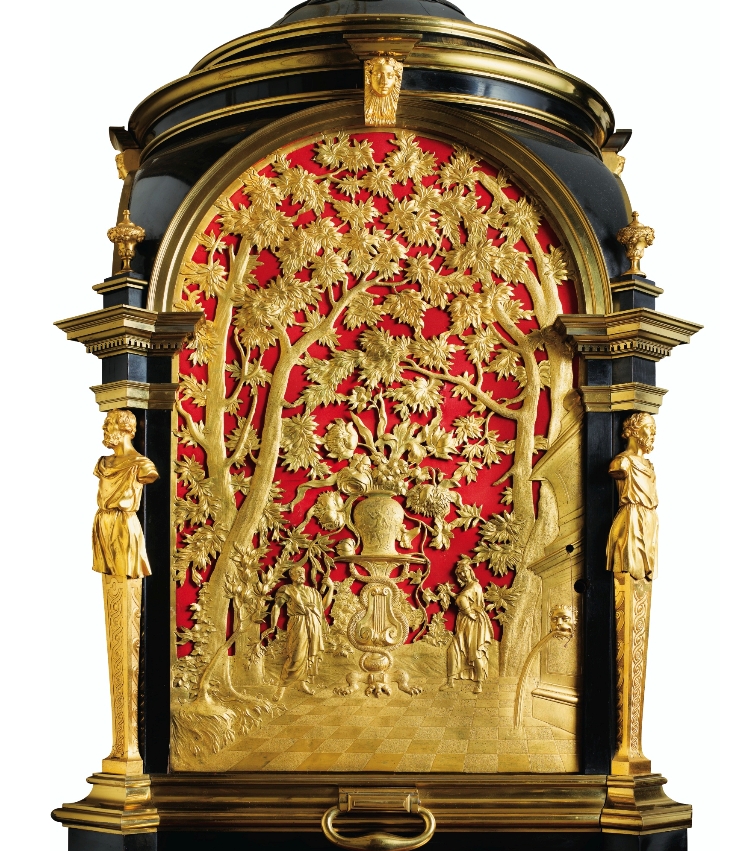The Charles Clay Musical Clocks - Repost.
Somehow the original post became corrupted.
The Charles Clay Musical Clocks - Repost.
Charles Clay (d.1740).
The Mechanical Musical Clocks.
With Sculptural embellishments by Rysbrack and Roubiliac, Paintings by Amigoni and music by Handel.
Also including here are some notes on clocks made by John and his son George Pyke and Henry Bridge's Microcosm clock movement.
Edited and updated 13 Dec. 2022.
Amigoni (Amiconi) Venetian painter worked in London from 1730 - 1739
Amigoni (Amiconi) Venetian painter worked in London from 1730 - 1739
Originally from Stockton, Yorkshire Charles Clay trained as a machine watchmaker.
First noted when he petitioned parliament for a patent for a musical repeating watch or clock - unfortunately the Quaker Daniel Quare who had produced a similar mechanism at the same time opposed Clay's application and was supported by the Company of Clock Makers.
Although there was prolonged litigation (at the considerable cost of £73 -17s - 11d) to the Company from February 1716 until the latter months of 1717, Quare was finally successful in and Clay's petition for a patent was refused.
He was established in near St Mary le Strand by at least 1720, where he remained until his death 20 years later. By 1723 he was appointed Clockmaker to His Majesty's Board of Works, a post he held for the remainder of his life. In 1731 he supplied the clock over the gateway at St James's Palace.
The 'Temple of the Four Great Monarchies of the World' was put on display shortly after his death; the clock had been completed by John Pyke, a clock and watch maker of Bedford Row who had been apprenticed in 1710 and admitted to the Freedom of the Clockmakers' Company in 1720.
The 'Temple of the Four Great Monarchies of the World' was put on display shortly after his death; the clock had been completed by John Pyke, a clock and watch maker of Bedford Row who had been apprenticed in 1710 and admitted to the Freedom of the Clockmakers' Company in 1720.
1737. June 16th. Mr Clay's fine musical clock lately raffled
was won by Mr Hayley. (Derby Mercury Newspaper).
A List of the Mechanical Musical Clocks by Charles Clay.
1. Museum of the Royal Palace, Beijing, signed and dated 1730. Organ still in place.
2. Royal Palace, Naples. Signed twice 'Cha: Clay London' and Cha: Clay / Fecit 1730 '. Organ still in place.
3. Birmingham Museum and Art Gallery, 'Being the first made in perfection N ° 1 Cha: Clay London Fecit'. dated 1735 - Organ still in place.
4. The 'Braamcamp' / Braamkamp clock - c. 1736 - 40 - the Organ is still in place
Since my writing this post a new blog post has appeared regarding the restoration of this clock, see
5. Castleton House, Celbridge, Ireland.
6. Windsor Castle, Berkshire, GB. - Organ still in place.
7. Board Room, Treasury Buildings, London.
8. Kensington Palace, Temple of the Four Great Monarchies, London, 1740, completed by John Pyke. The Plinth is a modern replacement.
Also considered here is a mechanical music clock by Charles Pyke now at Temple Newsam House. Leeds, dated 1765.
_________________________________________________
The Charles Clay Musical Clock at Beijing.
The Charles Clay Musical Clock at Beijing.
Signed and dated 1730.
Low resolution photograph.
Museum of the Royal Palace, Beijing.
................................
Signed Cha: Clay London and Cha:Clay / Fecit 1730.
It is believed English-born Prime Minister of the Neapolitan Kingdom, Sir John Acton (1736–1810), bequeathed the clock to Maria Carolina, Queen of Naples between 1779 and 1798.
The dial plate features a near identical relief to the Beijing Apollo clock (see above).
...........................................
The Charles Clay Musical Clock at Birmingham Museum.
Birmingham Museum and Art Gallery.
7' 7" tall overall.
A small weight driven pipe organ is housed inside and is operated by a tune barrel, which
is engraved as follows, ‘Being the first/made in perfection/N: 1 Cha: Clay London Fecit.’
The small dial is exactly the same as those on the Beijing and Naples Clocks (see above).
Signed and Dated 1735.
Acquired from the collection of Lord Burnham at the sale of the contents of Hall Barn House, Buckinghamshire in September 1969.
The original repertoire still remains engraved on the scroll, which is held by the gilt bronze
winged figure that surmounts the case.
winged figure that surmounts the case.
The right arm of the figure was used to select
the tune.
the tune.
The scroll reads: Sonata/Traveste /Aria/Gavotta/Traveste/Arieta/Arieta/
Traveste/Praelude.5
Traveste/Praelude.5
Evidence suggests that the original music shown on the scroll was
written by Handel.
written by Handel.
....................................
The Gerret Braamkamp Musical Clock by Charles Clay.
from the collection of Gerret Braamkamp (1699 - 1771).
c. 1736 - 40.
Signed C. Clay on the dial. and Cha. Clay London on the Cylinder.
Sold at the Robert de Balkany Sale 2016 to the Museum Speelklok.
Gerrit Braamcamp, Distiller, timber merchant, shipbuilder and art collector.
Frontispiece to Le Temple des Arts ou Le Cabinet de M Braamcamp by M. de Bastide.
Amsterdam 1766.
Frontispiece to Le Temple des Arts ou Le Cabinet de M Braamcamp by M. de Bastide.
Amsterdam 1766.
Engraving Reinier Vinkeles after Jacob Xavery.
213 x 153 mm.
for the remarkable collection of Gerrit Braamcamp see -
Photographs Courtesy Sotheby's, Paris.
http://www.sothebys.com/fr/auctions/ecatalogue/lot.120.html/2016/robert-de-balkany-rue-de-varenne-paris-pf1660
















No comments:
Post a Comment